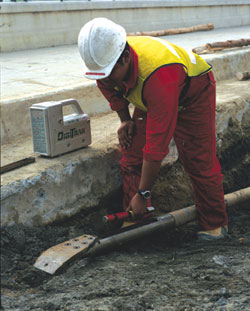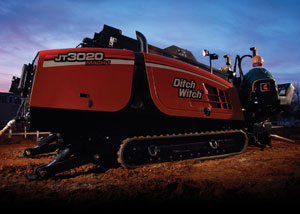Join the Drill Team
 Saddled to the side of a compact HDD rig, a skillful operator can deftly pilot a subterrestrial jobsite. A surface-launched compact horizontal drilling rig (or compact HDD unit) can uniquely install utilities by boring beneath the earth, causing minimal impact on the surrounding surface area.
Saddled to the side of a compact HDD rig, a skillful operator can deftly pilot a subterrestrial jobsite. A surface-launched compact horizontal drilling rig (or compact HDD unit) can uniquely install utilities by boring beneath the earth, causing minimal impact on the surrounding surface area.
Snug in the operator’s station with a hard hat and sunglasses, the HDD driver feathers two levers — one for controlling the pushing power to the drill rod going into the ground and one to direct the front drill head that’s boring through the earth.
A small box of levers nearby controls the unit’s mud system, which lubricates the drill rod and hole to make the boring easier. Across the street, a co-pilot is holding a locator, which is tracking the drill head as it moves underground (nearly 100 ft to the house), decoding steering directions and tracing its unseen path.
This crew can navigate through a variety of ground conditions (from moist Midwest loam to rocky Southwestern caliche), carefully avoiding a vast network of sunken utilities, to install the gamut of public and private services — water, sewer, gas, fiber and telephone. This type of utility installation is called a “trenchless technology” because it avoids the majority of excavation and restoration work involved on a project. When you consider the sprawl of urbanized jobsites in cities and neighborhoods around the United States, evasive construction techniques are becoming more than an alternative.
“Trenchless technology is beginning to be the method of choice in some markets for installing underground infrastructure. It’s replacing open-cut,” says Richard Levings, HDD product manager at Ditch Witch. “It’s an exciting time to be in the HDD industry. There is certainly a lot of work. Fiber is something that’s driving work in the small sized units, as well as upgrades of services in water and gas and the oncoming services for sewer and electric. A lot of the overhead utilities are going underground too and that has driven a good solid market for us — particularly in North America.”
Carefully place a compact HDD rig on the lawn of an upscale residence or next to the city’s busiest boulevard and it can install underground utilities with minimal impact to surface activity. With the right-sized rig, proper operating procedures and an experienced crew, contractors and utility companies can direct subsurface construction without disrupting the ebb and flow of everyday life, upgrading and improving their aging infrastructure and polishing their quality of construction.
Underground Iron Works
Utilities are complicated constructs. Every community, company and country relies on a complex network of power, water and communication services to function in the 21st century. When these utilities are underground (wires, cables, pipes and beyond), they become an even more intricate and invisible substratum of services.
This makes subsurface drilling a precise application in urban areas. When working in such a complicated and concealed environment, professionals need a machine that is going to be powerful, flexible and safe. For the last 20 years, manufacturers have been tweaking the design of horizontal directional drills to bore beneath the ground in order to install new utilities with minimal risk.

The pilot hole can be drilled to precise locations because of the drilling tool’s slanted steering plate. The orientation of the tool and its slanted steering plate is what determines the direction the tool will move when pushed into the ground without rotation. The steering plate reacts off the soil and the deviation in the tool’s direction is achieved.
Once the pilot hole has been completed (the drill tool arrives at the exit location), the drilling tool is removed and a hole opening device, called a reamer, is attached.
The reamer is then attached to a conduit, referred to as the product pipe. This assembly is pulled back through the pilot hole to the drill, resulting in a completed installation with minimal surface disruption.
HDD drills come in three main sizes — compact, mid-sized and maxi rigs. The units are categorized in size by pullback force: compact (20,000 lbs and below); mid-size (20,000 to 100,000 lbs); and maxi (100,000 lbs and higher). The largest machines can cross giant rivers and the smallest can be used for quick 100-ft shots from the street to your house; Compact Equipment favors the smaller variety.
“Typically, compact rigs are defined by their size,” explains John Olander, compact HDD specialist at TT Technologies. “They are relatively lightweight. They are smaller than standard-sized drill rigs. They can work in tight, residential areas. They also tend to be about 36 in. in width so they can fit through a standard yard gate. Portability is another factor. Most compact drills can be legally towed behind a 1-ton truck.”
Pretty much all the compact directional drills that are manufactured in North America are self-contained units, which means most every system comes with the base unit, including an anchor, transport undercarriage, operator’s station, drill stem, locator system and fluid mixing unit. The top manufacturers of these compact HDD systems in the United States include Ditch Witch, Vermeer, Astec Underground and TT Technologies. Prices for the smallest rigs will range from $60,000 to $170,000 today, depending on how it is customized.
“When it comes to defining compact drills, they normally drill at depths of 5 ft or less, although the locators can go to 70 ft depths,” says Ed Savage, trenchless segment manager at Vermeer Mfg. Co. “Compact drills normally bore 400 ft or less in length. Some bores will stretch out to the 600-ft range depending on ground conditions and the type and size of product being installed. Small drills install almost any service lines — water, gas, electric, communication, sewer and irrigation.”
Systems Analyses
Trenchless directional drilling takes teamwork — not only from a crew of professionals, but also from a symbiosis of different machine systems. When the team and machine function in synchronicity, they can operate an HDD unit safely and efficiently. The tools for the trade are many.
“Some of the ancillary products that go along with an HDD unit are drill pipe, locating equipment, downhole tooling and mud mixing equipment,” says Carl Seeliger, trenchless product manager at Astec Underground. “The drill pipe is used to transmit power from the rotational powered component to the downhole cutter. It’s also used to pull the product through the ground to complete the bore. Locating equipment is used to guide the HDD operator to the exit point where the final product will be pulled into the ground. This equipment can provide depth, transmitter pitch, temperature and additional information about the equipment. These are all important tools that an HDD team will use to make sure a successful bore is completed on time and with as few problems as possible.”
One of the most important systems in horizontal directional drilling would have to be the lubricating fluid and mixing system. Crews use a mixture of water and bentonite or polymer that continuously flows to the cutting head to facilitate the removal of cuttings, stabilize the bore hole, cool the cutting head and lubricate the passage of the product pipe. To mix and pump these drilling fluids, contractors will need a mud mixing system.

Most small rig mud systems are only 200 to 500 gal and they range from $4,000 to $7,000 in price. Location and guidance of the drill is just as important as the lubrication of the hole. The function of the HDD crew’s locating system is to provide the driller with information on the tool’s position and heading to guide the pilot hole process. This information includes the clock or roll position (steering orientation of the tool is analogous to a 12-hour clock face), inclination (pitch), depth, heading (direction), temperature and battery status. To constantly track the bore, a crew will need a locating system, which includes a handheld locater, a remote display for the drill operator and a sonde and sonde housing for the drill head. Using a hand-held locator at the surface, a crew member is manually positioned over the sonde, where he or she has the signal decoded and steering directions are relayed to the bore machine operator.
“On these more compact units, they typically go with the lower-end tracking systems that are typically more cost-effective for the type of work they’re doing,” says Levings. “The tracking system usually consists of an electronic beacon — some people call them sondes — in the drill head. And then you will have the receiver on the surface and for most of these units, then you will have remote display that mounts internally in the rig. This is at least a two-man operation.”
The ease of use (a locating system that allows for quick training), the types of projects (shallower installations may not require deep range transmitters), size of the drilling machine (rig size can potentially dictate the scope of work undertaken), flexibility of the operation (once a locating system has been selected, it can become expensive to change the system later) and support of the product (the availability of technical assistance is critical) are all key factors in the purchase.
Tools and Trends
With the locating system mentioned above, the sonde and sonde housing will actually fall under the tooling category along with various types of drill heads and backreamers, depending on the drilling situation, along with pipe pulling attachments and swivels. About 150 to 400 ft of drill pipe comes with each compact unit (and costs about $8,000 to $15,000 to replace).
When it comes to drilling heads, bits will change depending on ground conditions — loam, sand, clay, rocky soils or other underground environments. There are a variety of bit options sold from HDD manufacturers and other OEMs like Melfred Borzall, INROCK and Sharewell. They are made for every type of unique ground condition and they come with cool, hard-nosed names.
Stop by a Ditch Witch dealer and you’ll find the popular Tuff Bit, which is designed for hard compacted soils, soft sedimentary rock and has the strength and stability to handle the pounding and vibration of drilling in rock.

“Ground conditions significantly affect machine operations. It influences everything,” says Olander. “The best soil conditions are sandy loam and the worst are solid rock. You need to prepare differently for each condition you encounter. The variables change as the soil conditions change.”
Finally, take a look at specific safety and performance features from each manufacturer when picking the perfect compact HDD rig. Does the unit have a safety lockout system, track choices, load sensing hydraulics, rapid travel system or cruise control?
“There is such a broad list of additional features on HDD rigs as compared to drills offered five to six years ago,” says Seeliger. “With microprocessor technology becoming less expensive, we are seeing more and more being incorporated on HDD rigs. You now have cruise control, horsepower control monitoring, automated pipe loading features and assisted troubleshooting. The continued development of compact hydraulic systems, fluid delivery components and innovative advancements in control applications will continue to increase the available options.”

Comments are closed here.